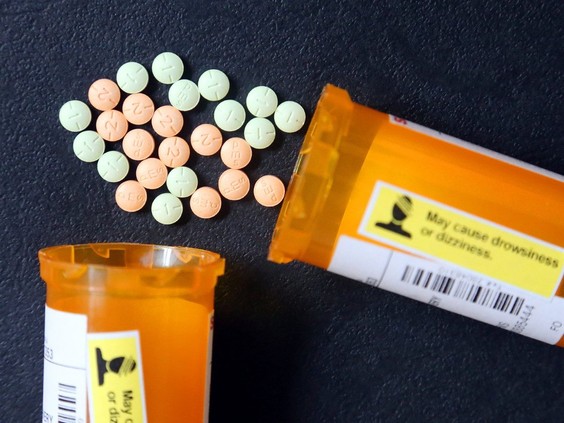Pioneers in 'Safer Supply' British Columbia Benefits the Opioid Black Market
"Significant [quantities of] safer supply [opioids are being diverted to the black market with assistance of organized gangs and some unscrupulous health-care providers].""Taxpayer-funded 'safe supply' drugs are flooding the streets, enriching organized crime, in some cases with diversion fraudulently facilitated by pharmacies and medical professionals.""A significant portion [of safer supply opioids are being diverted to the black market, where they are being trafficked] provincially, nationally and internationally."Power Point presentation produced by British Columbia's Ministry of Health
 |
| A memorial wall for people who died as a result of using drugs is featured inside the offices of the Vancouver Area Network of Drug Users, a nonprofit group. The New York Times |
"The last six months of 2020 they dispensed 577,000 opioid pills. In the two years between 2022 and 2024, it was over 22 million. It's humiliating. How many people are living in British Columbia, for goodness sake?""We've got to stop calling things harm reduction. It's not proven.""Is giving people giant buckets full of hydromorphone to dump into the community harm reduction? No. It's not proven to reduce harm. It's not evidence-based. It's an experiment.""Of course we need to deal with kickbacks from pharmacies. Even if every pharmacy is on the straight and narrow, it would still be a problem. A huge problem.""We're not talking about safe injection sites at all. You're giving dope to people who are addicted and they're not taking it. They're using it as a currency to buy street drugs and still put themselves at risk."B.C. MLA Elenore Sturko
 |
| Hydromorphone, a type of opioid, is pictured at a managed opioid program in 2019. The drug is among those whose prescriptions have dramatically increased in recent years. The province is investigating the diversion of a 'significant portion' of opioids. (Ashley Burke/CBC) |
Part
of a confidential report produced by British Columbia's Ministry of
Health summarizing findings of a special investigative unit looking into
the fallout of the province's initiative to react to the growing
phenomenon of fentanyl overdoses leading to death that has swept Canada,
and manifested hugely in British Columbia, has been leaked. Its
findings discovered that the freely distributed hydromorphone that has
been handed out to people addicted to opioids has flooded the streets,
the result of that free hydromorphone being bartered for more potent
fentanyl craved by drug addicts.
The
cheaper and more freely available handout drugs on the streets have
made their way into the hands of teenagers which has resulted in a
growing use of drugs with occasionally fatal consequences for young
people. Government agencies have denied that the 'safer supply' they
have invested so heavily in relating to their open-minded search for a
solution to the fentanyl black market, could be ending up on the streets
in a black market bonanza. Yet reports from hospital personnel, police,
and community investigators have all held the government to fault for a
situation that really is imperilling a greater swath of the population,
despite government denials.
Now,
years after the accusations of government ineptness and malcompetence
made the news, a leaked document -- that investigators have produced
verifying the accusations -- has surfaced. Even before that, however,
the government of B.C. came to a decision to curtail their experiment in
'harm reduction' through 'safer supply'. No longer able to deny that
throughout this experiment, accidental deaths due to overdoses have
increased, not diminished, and a wider net has been cast in the process,
capturing a younger cohort in the drug spiral.
Within
the presentation photos of diverted safe supply prescriptions still in
their original packaging were included; evidently having been
confiscated during vehicle searches by police. At least 60 British
Columbia pharmacies were identified by the investigative unit as having
provided prohibited paid "incentives" to clients, doctors and assisted
living residences for the purpose of increasing their operating
profits.
 |
A
dispensing fee is charged for each prescription filled; in this
instance billed to the provincial government. Up to three prescriptions a
day can be dispensed for a single safer supply patient. Dispensing fees
are around $10 each, so the potential for pharmacies to earn up to
$11,000 annually for each safer supply patient served is a compelling
temptation. Normal customers are worth around $120 in dispensing fees
yearly. The obvious conclusion is that a single safer supply patient can
result in more revenue than 90 others not related to safer supply
combined, would produce.
According
to the leaked presentation, some 'incentivized' patients may procure
only one of their three daily prescriptions while diverting their extra
opioids to the black market. Alternately, the pharmacy involved could
fraudulently bill the province while failing to dispense the drugs, so
that patients don't receive some or all of their prescriptions. Either
way, extra opioids end up on the black market fueling organized crime
and leading to an increase in drug use in the population.
According to the presentation, between 2022 and 2024, some 20-million milligrams of hydromorphone (an opioid as potent as heroin)
and 232,000 fentanyl patches were dispensed through safer supply, equal
to 19 percent of all the hydromorphone and 13 percent of all the
fentanyl patches dispensed during this period in the province.
 |
| Some pharmacies are paying cash kickbacks to vulnerable patients in Vancouver’s Downtown Eastside to attract more business — years after crackdowns related to the practice. CBC News |
Labels: 'Safer Supply' Black Market, British Columbia, Fentanyl, Hydromorphone

<< Home